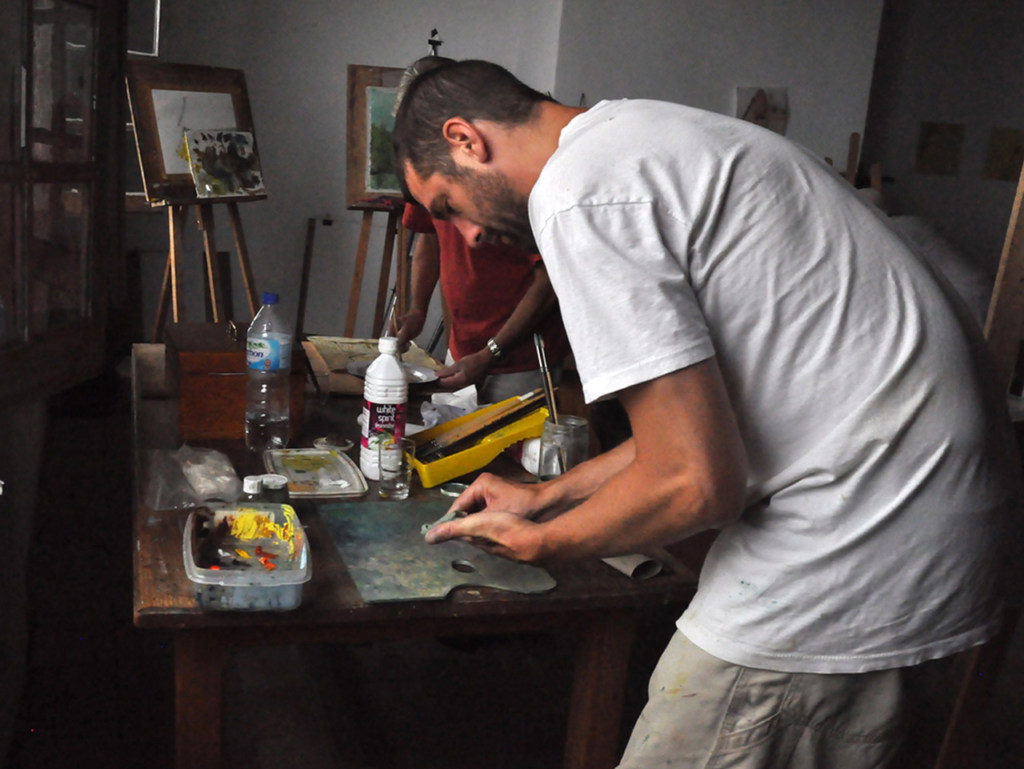This is the second of five posts on colour-mixing. It continues the process of preparing for three more practical chapters that follow. It role is to confront a number of commonly held misunderstandings relating to the ‘colour circle’.
Following the image of a student getting ready to mix a colour, there is a slightly edited version of the Introductory to the chapter and a link to it the whole text.

Introductory
At my painting school, I give talks on colour-mixing. The chapter which I am publishing in this Post as well as the next three chapters (all of which I will publish in the near future) are based on these. Between them they both flesh out some of the claims made in the previous chapter and provide a sound and practical approach to colour-mixing. My purpose is to provide help with:
- Finding a maximum of colours in any part of the colour sphere (as described in the last chapter).
- Creating a sense of light, space and harmony in paintings.
The first of my talks concerns colour-mixing by stirring (as opposed to colour mixing by layering, which I will deal with later). Experience has shown that for many people coming to my Painting School for the first time, it is necessary to start my explanations at the most basic levels. Accordingly, I introduce my talk by apologising in advance for going over ground that may already be familiar to some, but suggest that it is better to be absolutely sure of building on common and solid foundations. Also, my decision to repeat the structure of my Painting School lesson means that some of the material that appeared in the previous chapter, is presented again in this chapter, although in slightly different ways.
.
CHAPTER 12 – REFINING THE COLOUR CIRCLE
.
Other Chapters from “Painting with Light and Colour”
- Introduction: the little known Science behind many of the original practical suggestions.
- Chapter 1 : The dogmas
- Chapter 2 : Doubts
- Chapter 3 : The nature of painting
- Chapter 4: Renaissance ideas
- Chapter 5 : New Science on offer
- Chapter 6 : Early Modernist Painters
- Chapter 7 : The perception of surface
- Chapter 8 : Seurat and Painting with Light
- Chapter 9 : Seeing Light
- Chapter 10 : Illusory pictorial space and light
- Chapter 11 : Colour mixing – definitions and misconceptions
- Chapter 12 – Refining the colour circle
Francis, I have just read Chapter 12 for the first time, and it’s a revelation (especially your ‘orange line’). I enjoyed the scientific logic. Makes me want to start painting.
Frances
Francis,
Thank you. This is really helpful. A reference chapter that I will be returning to, more than once, as I continue to move forward with color.
Regards,
Sylvia
Hello Francis, Thank you for posting more information about colour mixing, it’s a fantastic resource because [appart from at Montmiral] I’ve never found all of this info 1] all in one place 2] explained well 3] backed up by scientific evidence. 4] Integrated into art history. The info of the colour circle- developing into the colour sphere, and its practical implications for artists formed the basis of all my colour workshops which I delivered to numerous art groups as part of painting classes for 2 decades. I did credit you- by the way! Established dogmas are just that; many adult ed students found it very difficult to realize that colour mixing has its basis in science and perception rather than simply in the sort of colour recipes given in teach yourself ‘how to paint trees’ books. Which was their main or only source of prior guidance. In addition, the basics of colour mixing was only discussed once in my entire Art School training. It wasn’t done as well as you have presented it and contained some errors. So bravo. This knowledge deserves greater exposure, but as we know quality isn’t any guarantee of public or academic acceptance.
Thanks Mark. You will not be surprised to hear that I agree with everything you write.
Thank you Francis. I have benefitted hugely from your understanding about color and much besides over the years. It is original and so incredibly helpful.
Again, thanks!